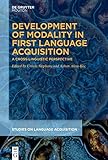Development of Modality in First Language Acquisition : A Cross-Linguistic Perspective / ed. by Ursula Stephany, Ayhan Aksu-Koç.
Material type: TextSeries: Studies on Language Acquisition [SOLA] ; 54Publisher: Berlin ; Boston : De Gruyter Mouton, [2021]Copyright date: ©2021Description: 1 online resource (X, 593 p.)Content type:
TextSeries: Studies on Language Acquisition [SOLA] ; 54Publisher: Berlin ; Boston : De Gruyter Mouton, [2021]Copyright date: ©2021Description: 1 online resource (X, 593 p.)Content type: - 9781501512452
- 9781501504358
- 9781501504457
- 401.93 23
- P118
- online - DeGruyter
- Issued also in print.
| Item type | Current library | Call number | URL | Status | Notes | Barcode | |
|---|---|---|---|---|---|---|---|
 eBook
eBook
|
Biblioteca "Angelicum" Pont. Univ. S.Tommaso d'Aquino Nuvola online | online - DeGruyter (Browse shelf(Opens below)) | Online access | Not for loan (Accesso limitato) | Accesso per gli utenti autorizzati / Access for authorized users | (dgr)9781501504457 |
Frontmatter -- Contents -- List of abbreviations used in the present volume -- Studying the acquisition of modality: An introduction -- Requests in first language acquisition of German: Evidence from high and low SES families -- Gender differences in the acquisition of requests in Lithuanian -- Development of directive expressions in Russian adult–child communication -- Acquisition of modality in Croatian -- Competition of grammatical forms in the expression of directives in early French child speech and child-directed speech -- On the acquisition of dynamic, deontic and epistemic uses of modal verbs in Romanian -- Development of modality in early Greek language acquisition -- Acquisition of requests in Estonian -- Directives in Finnish language acquisition -- Modality in child Hebrew -- Epistemic modality in Russian child language -- Epistemic and evidential modality in early Turkish child speech -- The development of sentence-ending epistemic/evidential markers in young Korean children -- The acquisition of evidentiality in two Mayan languages, Yukatek and Tojolabal -- Conclusions -- List of Contributors -- Subject Index
restricted access online access with authorization star
http://purl.org/coar/access_right/c_16ec
This book deals with the development of modality from a crosslinguistic perspective and is closely related to two earlier volumes on the development of verb and nominal inflection in first language acquisition (SOLA 21 and 30) both methodologically and theoretically. Each of the fourteen contributions studies the early development of the form and function of expressions of deontic and dynamic agent-oriented modality or epistemic and evidential propositional modality in one of fourteen languages belonging to different morphological types and language families (seven Indo-European and seven non-Indo-European). The analyses are mainly based on longitudinal observations of children in their 2nd and 3rd years of life in conversational interaction with their caregivers, mostly the mothers. Main issues addressed are the development of directives and modulations of information in terms of certainty and evidentiality, also taking into account children’s developing social-pragmatic and cognitive skills. One of the main findings is that agent-oriented and propositional modality may develop in parallel depending on the typological characteristics of the language acquired. The decisive factor is whether notions of propositional modality are grammaticized and obligatorily expressed in the language. The findings are interpreted within non-nativist theoretical frameworks (Usage-based theories, Natural Morphology).
Issued also in print.
Mode of access: Internet via World Wide Web.
In English.
Description based on online resource; title from PDF title page (publisher's Web site, viewed 25. Jun 2024)


